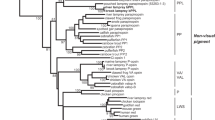Abstract.
Circadian pacemaker cells in the eyes of the opisthobranch mollusc Bulla gouldiana generate a near 24-h rhythm in the frequency of optic nerve impulses. Previous electrophysiological studies suggest that these basal retinal neurons are intrinsically photosensitive and transduce light signals that shift the phase of their pacemaker mechanism. To test whether the pacemaker neurons contain opsin-like proteins, several polyclonal antibodies that recognize opsins of vertebrate photoreceptors have been tested on histological sections of the eye and on the neurons in primary cell culture. The antibodies label both the pacemaker cells and the large distal photoreceptors that surround the lens. Immunoblot analyses of the proteins of the eye have identified a single band at 62±4 kDa. These opsin antibodies may label the photopigment used in the entrainment of the circadian pacemaker.
Access this article
We’re sorry, something doesn't seem to be working properly.
Please try refreshing the page. If that doesn't work, please contact support so we can address the problem.
Similar content being viewed by others
Author information
Authors and Affiliations
Additional information
Received: 20 September 1995 / Accepted: 17 July 1996
Rights and permissions
About this article
Cite this article
Geusz, M., Foster, R., DeGrip, W. et al. Opsin-like immunoreactivity in the circadian pacemaker neurons and photoreceptors of the eye of the opisthobranch mollusc Bulla gouldiana . Cell Tissue Res 287, 203–210 (1996). https://doi.org/10.1007/s004410050746
Issue Date:
DOI: https://doi.org/10.1007/s004410050746




